Teledyne 3000TA-XLEU User Manual
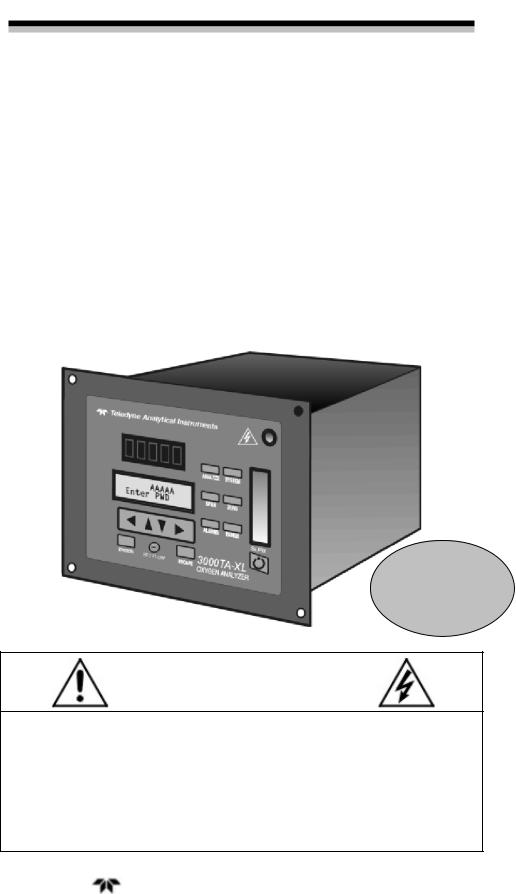
Trace Oxygen Analyzer
OPERATING INSTRUCTIONS FOR
MODEL 3000TA-XL-EU
Trace Oxygen Analyzer
P/N M69603 12/02/13
DANGER
Toxic gases and or flammable liquids may be present in this monitoring system. Personal protective equipment may be required when servicing this instrument.
Hazardous voltages exist on certain components internally which may persist for a time even after the power is turned off and disconnected.
Only authorized personnel should conduct maintenance and/or servicing. Before conducting any maintenance or servicing, consult with authorized supervisor/manager.
|
|
Teledyne Analytical Instruments |
i |

3000TA-XL-EU
Copyright © 2013 Teledyne Analytical Instruments
All Rights Reserved. No part of this manual may be reproduced, transmitted, transcribed, stored in a retrieval system, or translated into any other language or computer language in whole or in part, in any form or by any means, whether it be electronic, mechanical, magnetic, optical, manual, or otherwise, without the prior written consent of Teledyne Analytical Instruments, 16830 Chestnut Street, City of Industry, CA 91748.
Warranty
This equipment is sold subject to the mutual agreement that it is warranted by us free from defects of material and of construction, and that our liability shall be limited to replacing or repairing at our factory (without charge, except for transportation), or at customer plant at our option, any material or construction in which defects become apparent within one year from the date of shipment, except in cases where quotations or acknowledgements provide for a shorter period. Components manufactured by others bear the warranty of their manufacturer. This warranty does not cover defects caused by wear, accident, misuse, neglect or repairs other than those performed by Teledyne or an authorized service center. We assume no liability for direct or indirect damages of any kind and the purchaser by the acceptance of the equipment will assume all liability for any damage which may result from its use or misuse.
We reserve the right to employ any suitable material in the manufacture of our apparatus, and to make any alterations in the dimensions, shape or weight of any parts, in so far as such alterations do not adversely affect our warranty.
Important Notice
This instrument provides measurement readings to its user, and serves as a tool by which valuable data can be gathered. The information provided by the instrument may assist the user in eliminating potential hazards caused by his process; however, it is essential that all personnel involved in the use of the instrument or its interface, with the process being measured, be properly trained in the process itself, as well as all instrumentation related to it.
The safety of personnel is ultimately the responsibility of those who control process conditions. While this instrument may be able to provide early warning of imminent danger, it has no control over process conditions, and it can be misused. In particular, any alarm or control systems installed must be tested and understood, both as to how they operate and as to how they can be defeated. Any safeguards required such as locks, labels, or redundancy, must be provided by the user or specifically requested of Teledyne at the time the order is placed.
Therefore, the purchaser must be aware of the hazardous process conditions. The purchaser is responsible for the training of personnel, for providing hazard warning methods and instrumentation per the appropriate standards, and for ensuring that hazard warning devices and instrumentation are maintained and operated properly.
Teledyne Analytical Instruments, the manufacturer of this instrument, cannot accept responsibility for conditions beyond its knowledge and control. No statement expressed or implied by this document or any information disseminated by the manufacturer or its agents, is to be construed as a warranty of adequate safety control under the user’s process conditions.
Teledyne Analytical Instruments |
ii |

Trace Oxygen Analyzer
|
|
|
Teledyne Analytical Instruments |
iii |
|

3000TA-XL-EU
Specific Model Information
The instrument for which this manual was supplied may incorporate one or more options not supplied in the standard instrument. Commonly available options are listed below, with check boxes. Any that are incorporated in the instrument for which this manual is supplied are indicated by a check mark in the box.
Instrument Serial Number: _______________________
Options Included in the Instrument with the Above Serial Number:
3000TA-XL -VS: Instrument configured for Vacuum Service
3000TA-XL-CV: Instrument with calibration valves
19" Rack Mnt: The 19" Relay Rack Mount units are available
with either one or two 3000TA-XL series analyzers installed in a standard 19" panel and ready to mount in a standard rack.
3000TA-XL-I Web enabled version.
Sensor Options Available for the Instrument with the Above Serial Number:
Insta-Trace B2CXL (Default)
L2CXL
Teledyne Analytical Instruments |
iv |
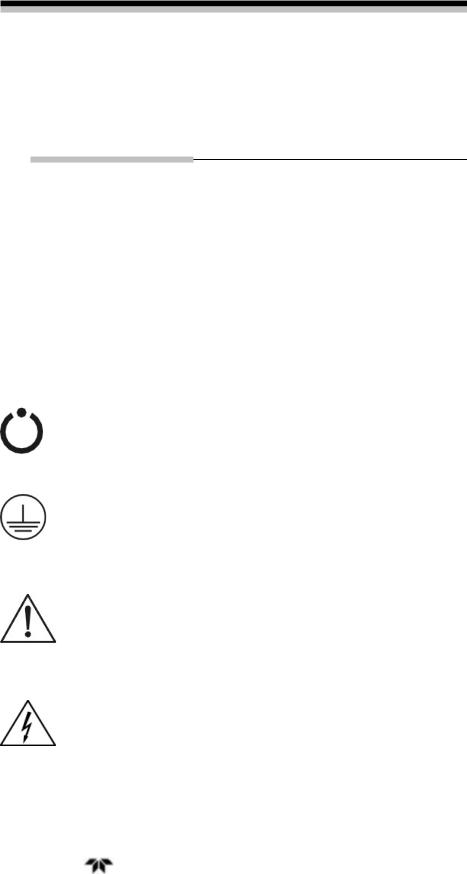
Trace Oxygen Analyzer
Important Notice
Model 3000TA-XL-EU complies with all of the requirements of the Commonwealth of Europe (CE) for Radio Frequency Interference, Electromagnetic Interference (RFI/EMI), and Low Voltage Directive (LVD).
The following International Symbols are used throughout the Instruction Manual. These symbols are visual indicators of important and immediate warnings and when you must exercise CAUTION while operating the instrument. See also the Safety Information on the next page.
STAND-BY: Instrument is on Stand-by, but circuit is active
GROUND: Protective Earth
CAUTION: The operator needs to refer to the manual for further information. Failure to do so may compromise the safe operation of the equipment.
CAUTION: Risk of Electrical Shock
|
|
|
Teledyne Analytical Instruments |
v |
|
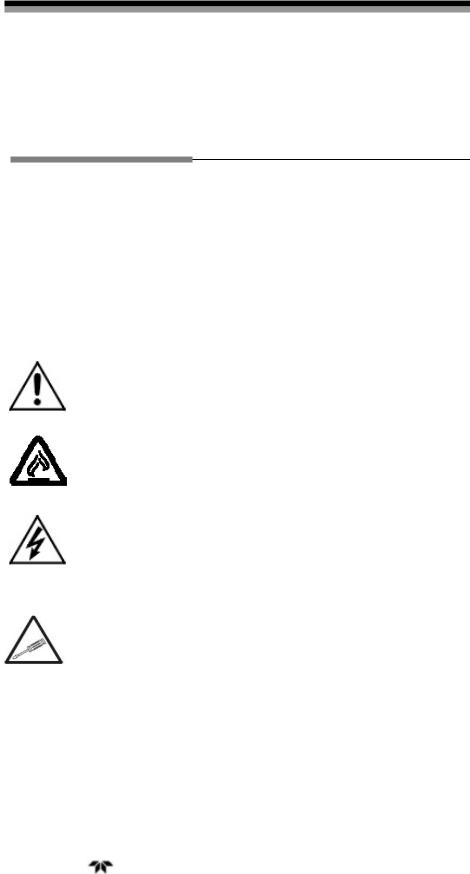
3000TA-XL-EU
Safety Messages
Your safety and the safety of others is very important. We have provided many important safety messages in this manual. Please read these messages carefully.
A safety message alerts you to potential hazards that could hurt you or others. Each safety message is associated with a safety alert symbol. These symbols are found in the manual and inside the instrument. The definition of these symbols is described below:
GENERAL WARNING/CAUTION: Refer to the instructions for details on the specific danger. These cautions warn of specific procedures which if not followed could cause bodily Injury and/or damage the instrument.
CAUTION: HOT SURFACE WARNING: This warning is
specific to heated components within the instrument. Failure to heed the warning could result in serious burns to skin and underlying tissue.
WARNING: ELECTRICAL SHOCK HAZARD: Dangerous
voltages appear within this instrument. This warning is specific to an electrical hazard existing at or nearby the component or procedure under discussion. Failure to heed this warning could result in injury and/or death from electrocution.
Technician Symbol: All operations marked with this symbol are to be performed by qualified maintenance personnel only.
No NOTE: Additional information and comments regarding a Symbol specific component or procedure are highlighted in the form
of a note.
Teledyne Analytical Instruments |
vi |

Trace Oxygen Analyzer
CAUTION: THE ANALYZER SHOULD ONLY BE USED FOR THE PURPOSE AND IN THE MANNER DESCRIBED IN THIS MANUAL.
IF YOU USE THE ANALYZER IN A MANNER OTHER THAN THAT FOR WHICH IT WAS INTENDED, UNPREDICTABLE BEHAVIOR COULD RESULT POSSIBLY ACCOMPANIED WITH HAZARDOUS CONSEQUENCES.
This manual provides information designed to guide you through the installation, calibration and operation of your new analyzer. Please read this manual and keep it available.
Occasionally, some instruments are customized for a particular application or features and/or options added per customer requests. Please check the front of this manual for any additional information in the form of an Addendum which discusses specific information, procedures, cautions and warnings that may be peculiar to your instrument.
Manuals do get lost. Additional manuals can be obtained from Teledyne at the address given in the Appendix. Some of our manuals are available in electronic form via the internet. Please visit our website at: www.teledyne-ai.com.
|
|
|
Teledyne Analytical Instruments |
vii |
|
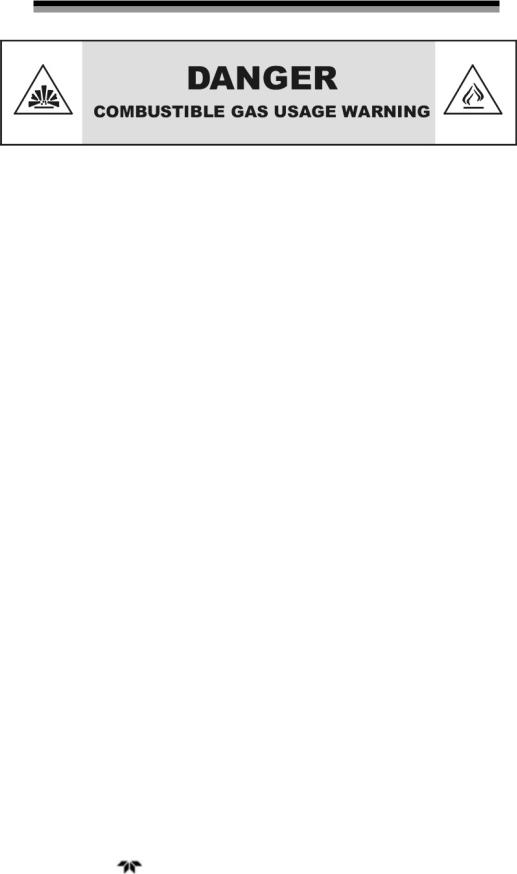
3000TA-XL-EU
This is a general purpose instrument designed for use in a nonhazardous area. It is the customer's responsibility to ensure safety especially when combustible gases are being analyzed since the potential of gas leaks always exist.
The customer should ensure that the principles of operation of this equipment are well understood by the user. Misuse of this product in any manner, tampering with its components, or unauthorized substitution of any component may adversely affect the safety of this instrument.
Since the use of this instrument is beyond the control of Teledyne, no responsibility by Teledyne, its affiliates, and agents for damage or injury from misuse or neglect of this equipment is implied or assumed.
Teledyne Analytical Instruments |
viii |
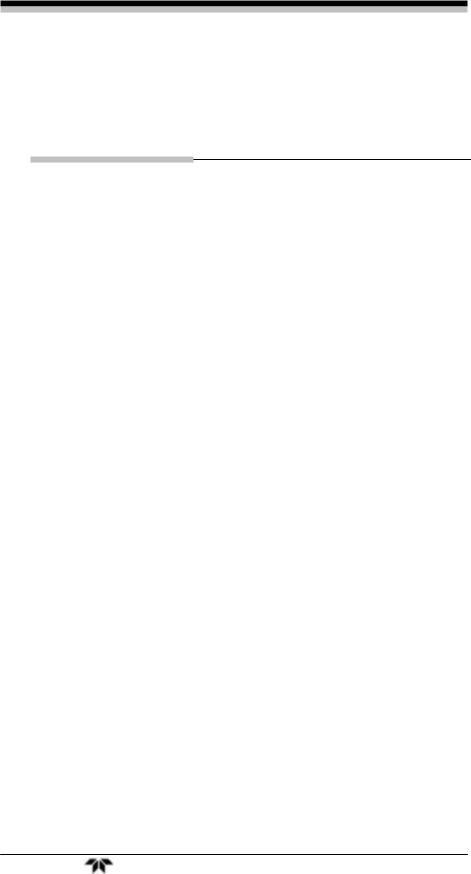
Trace Oxygen Analyzer
Table of Contents
Safety Messages .......................................................................... |
vi |
|
Introduction ................................................................................... |
1 |
|
1.1 |
Overview |
1 |
1.2 |
Typical Applications |
1 |
1.3 |
Main Features of the Analyzer |
1 |
1.4 |
Model Designations |
2 |
1.5 |
Front Panel (Operator Interface) |
3 |
1.6 |
Rear Panel (Equipment Interface) |
5 |
Operational Theory ....................................................................... |
7 |
|
2.1 |
Introduction |
7 |
2.2 |
Micro-Fuel Sensor |
7 |
2.2.1 Principles of Operation |
7 |
|
2.2.2 Anatomy of a Micro-Fuel Cell |
8 |
|
2.2.3 Electrochemical Reactions |
9 |
|
2.2.4 The Effect of Pressure |
10 |
|
2.2.5 Calibration Characteristics |
10 |
|
2.3 |
Sample System |
12 |
2.4 |
Electronics and Signal Processing |
15 |
Installation ................................................................................... |
19 |
|
3.1 |
Unpacking the Analyzer |
19 |
3.2 |
Mounting the Analyzer |
19 |
3.3 |
Rear Panel Connections |
21 |
3.3.1 Gas Connections |
21 |
|
3.3.2 Electrical Connections |
22 |
|
|
3.3.2.1 Primary Input Power |
23 |
|
3.3.2.2 50-Pin Equipment Interface Connector |
23 |
|
Teledyne Analytical Instruments |
ix |

3000TA-XL-EU
3.3.2.2.1 Analog Outputs |
23 |
|
3.3.2.2.2 Alarm Relays |
24 |
|
3.3.2.2.3 Digital Remote Cal Inputs |
26 |
|
3.3.2.2.4 Cal Contact |
26 |
|
3.3.2.2.5 Remote Calibration Protocol |
27 |
|
3.3.2.2.6 Range ID Relays |
27 |
|
3.3.2.2.7 Network I/O |
28 |
|
3.3.2.2.8 Remote Valve Connections |
28 |
|
3.3.2.3 RS-232 Port |
30 |
|
3.4 Installing the Micro-fuel Cell |
31 |
|
3.4.1 B-2CXL Micro-fuel Cell |
31 |
|
3.4.2 Insta-Trace Micro-fuel Cell |
32 |
|
3.5 Testing the System |
34 |
|
Operation ..................................................................................... 37 |
||
4.1 Introduction |
37 |
|
4.2 Using the Data Entry and Function Buttons |
38 |
|
4.3 The System Function |
40 |
|
4.3.1 Tracking the Oxygen Readings During Calibration and |
|
|
Alarm Delay |
41 |
|
4.3.2 Setting up an Auto-Cal |
42 |
|
4.3.3 Password Protection |
43 |
|
4.3.3.1 Entering the Password |
43 |
|
4.3.3.2 Installing or Changing the Password |
44 |
|
4.3.4 Logout |
46 |
|
4.3.5 System Self-Diagnostic Test |
47 |
|
4.3.6 Version Screen |
48 |
|
4.4 Calibration of the Analyzer |
48 |
|
4.4.1 Zero Cal |
49 |
|
4.4.1.1 Auto Mode Zeroing |
49 |
|
4.4.1.2 Manual Mode Zeroing |
50 |
|
4.4.1.3 Cell Failure |
51 |
|
4.4.2 Span Cal |
51 |
|
|
|
|
Teledyne Analytical Instruments |
x |
|

Trace Oxygen Analyzer
|
4.4.2.1 Auto Mode Spanning |
51 |
|
4.4.2.2 Manual Mode Spanning |
52 |
4.4.3 Span Failure |
53 |
|
4.5 |
Switching of Sample Streams |
54 |
4.5.1 Special Notes on Hydrogen Gas Stream |
55 |
|
4.6 |
The Alarms Function |
55 |
4.7 |
The Range Function |
57 |
4.7.1 Setting the Analog Output Ranges |
58 |
|
4.7.2 Fixed Range Analysis |
59 |
|
4.8 |
The Analyze Function |
59 |
4.9 |
Signal Output |
60 |
4.10 The IP Address Function |
61 |
|
4.11 Cold Boot to Return to Default Settings |
62 |
|
Web Implementation ................................................................... |
63 |
|
5.1 |
The Embedded Browser |
63 |
5.2 |
Remote Calibration |
65 |
5.2.1 Remote Span |
65 |
|
5.2.2 Remote Zero |
67 |
|
5.3 |
Set the Alarms Remotely |
68 |
5.4 |
Set the Ranges Remotely |
69 |
5.5 |
System Menu |
70 |
5.6 |
The Self-Test function |
71 |
Maintenance................................................................................. |
73 |
|
6.1 |
Routine Maintenance |
73 |
6.2 |
Cell Replacement |
73 |
6.2.1 Storing and Handling Replacement Cells |
73 |
|
6.2.2 When to Replace a Cell |
74 |
|
6.2.3 Removing the Micro-Fuel Cell |
75 |
|
6.2.4 Installing a New Micro-Fuel Cell |
75 |
|
6.2.5 Cell Warranty |
77 |
|
6.3 |
Fuse Replacement |
78 |
6.4 |
System Self Diagnostic Test |
79 |
|
Teledyne Analytical Instruments |
xi |

3000TA-XL-EU
6.5 |
Major Internal Components |
80 |
|
6.6 |
Cleaning |
81 |
|
6.7 |
Troubleshooting |
81 |
|
Appendix...................................................................................... |
83 |
||
A-1 |
Specifications |
83 |
|
A-2 Recommended 2-Year Spare Parts List |
85 |
||
A-3 |
Drawing List |
86 |
|
A-4 |
19-inch Relay Rack Panel Mount |
86 |
|
A.5 |
|
Application notes |
87 |
Material Safety Data Sheet |
89 |
||
Teledyne Analytical Instruments |
xii |

Trace Oxygen Analyzer
List of Figures
Figure 1-1: Model 3000TA-XL-EU Front Panel |
3 |
|
Figure 1-2: Model 3000TA-XL Rear Panel |
6 |
|
Figure 2-1: Micro-Fuel Cell |
8 |
|
Figure 2-2: Cross Section of a Micro-fuel Cell (not to scale) |
9 |
|
Figure 2-3: Characteristic Input/Output Curve for a Micro-Fuel |
|
|
Cell |
11 |
|
Figure 2-4: Piping Layout |
13 |
|
Figure 2-5A: Flow Diagram—Sample Under Pressure-Standard |
14 |
|
Figure 2-5B: Flow Diagram—Low Pressure-Model 3000TA-XL-VS14 |
||
Figure 2-5C: Flow Diagram—Sample Under Pressure-Model |
|
|
3000TA-XL-CV |
14 |
|
Figure 2-6: Power supply and PCB Location |
15 |
|
Figure 2-7: Block Diagram of the Model 3000TA-XL-EU |
|
|
Electronics |
16 |
|
Figure 3-1: Front Panel of the Model 3000TA-XL-EU |
20 |
|
Figure 3-2: Required Front Door Clearance |
20 |
|
Figure 3-3: Rear Panel of the Model 3000TA-XL-EU |
21 |
|
Figure 3-4: Equipment Interface Connector Pin Arrangement |
23 |
|
Figure 3-5: Remote Probe Connections |
29 |
|
Figure 3-6: FET Series Resistance |
29 |
|
Figure 3-7: Installing the B-2CXL MFC (other cells similar) |
32 |
|
Figure 3-8: Installing the Insta-Trace Micro-fuel Cell |
34 |
|
Figure 4-1: Hierarchy of Available Functions |
39 |
|
Figure 5-1: Analyzer Status Window—Running |
64 |
|
Figure 5-2: Span Calibration Window |
66 |
|
Figure 5-3: Zero Calibration Window |
67 |
|
Figure 5-4: Set Alarms Window |
68 |
|
|
|
|
Teledyne Analytical Instruments |
xiii |
|

3000TA-XL-EU
Figure 5-5: Set Range Window |
69 |
Figure 5-6: System Window |
70 |
Figure 5-7: Self-Test Window |
71 |
Figure 6-1: Removing the Micro-Fuel |
76 |
Figure 6-2: Installing the Insta-Trace Cell |
77 |
Figure 6-3: Removing Fuse Block from Housing |
78 |
Figure 6-4: Installing Fuses |
79 |
Figure 6-5: Rear Panel Removal |
80 |
Figure A-1: Single and Dual 19" Rack Mounts |
86 |
Teledyne Analytical Instruments |
xiv |

Trace Oxygen Analyzer
List of Tables
Table 3-1: Analog Output Connections |
24 |
Table 3-2: Alarm Relay Contact Pins |
25 |
Table 3-3: Remote Calibration Connections |
26 |
Table 3-4: Range ID Relay Connections |
28 |
Table 3-5: Commands via RS-232 Input |
30 |
Table 3-6: Required RS-232 Options |
30 |
Table 4-1: Output Signals |
60 |
Table 4-2: Range ID Output Voltage |
61 |
Table 6-1: Self Test Failure Codes |
79 |
|
|
|
Teledyne Analytical Instruments |
xv |
|

Trace Oxygen Analyzer |
Introduction |
|
|
|
|
|
|
|
Introduction
1.1 Overview
The Teledyne Analytical Instruments Model 3000TA-XL-EU Trace Oxygen Analyzer is a versatile microprocessor-based instrument for detecting oxygen at the parts-per-million (ppm) level in a variety of gases. This manual covers the Model 3000TA-XL-EU General Purpose flush-panel and/or rack-mount units only. These units are for indoor use in a nonhazardous environment.
1.2 Typical Applications
A few typical applications of the Model 3000TA-XL-EU are:
Monitoring inert gas blanketing
Air separation and liquefaction
Chemical reaction monitoring
Semiconductor manufacturing
Petrochemical process control
Quality assurance
Gas analysis certification.
1.3 Main Features of the Analyzer
The Model 3000TA-XL-EU Trace Oxygen Analyzer is sophisticated yet simple to use. The main features of the analyzer include:
A 2-line alphanumeric vacuum fluorescent display (VFD) screen, driven by microprocessor electronics, that continuously prompts and informs the operator.
High resolution, accurate readings of oxygen content from low ppm levels through 25%. Large, bright, meter readout.
Stainless steel cell block.
|
|
|
Teledyne Analytical Instruments |
1 |
|

Introduction |
3000TA-XL-EU |
|
|
|
|
|
|
|
Advanced Micro-Fuel Cell, designed for trace analysis, has a 0-1 ppm low range with less than a 0.2 ppm offset and six months warranty and an expected lifetime of one year.
Versatile analysis over a wide range of applications.
Microprocessor based electronics: 8-bit CMOS microprocessor with 32 kB RAM and 128 kB ROM.
Three user definable output ranges (from 0-1 ppm through 0- 250,000 ppm) allow best match to users process and equipment.
Air-calibration range for spanning at 20.9 % (209,000 ppm) available.
Auto Ranging allows analyzer to automatically select the proper preset range for a given measurement. Manual override allows the user to lock onto a specific range of interest.
Two adjustable concentration alarms and a system failure alarm.
Extensive self-diagnostic testing, at startup and on demand, with continuous power-supply monitoring.
Two way RFI protection.
RS-232 serial digital port for use with a computer or other digital communication device.
Four analog outputs: two for measurement (0–1 V dc and Isolated 4–20 mA dc) and two for range identification.
Convenient and versatile, steel, flush-panel or rackmountable case with slide-out electronics drawer.
1.4Model Designations
3000TA-XL: 3000TA-XL-VS: 3000TA-XL-CV: 3000TA-XL-I:
Standard model for sample under pressure Instrument configured for Vacuum Service Instrument with calibration valves
Web enabled version
Teledyne Analytical Instruments |
2 |
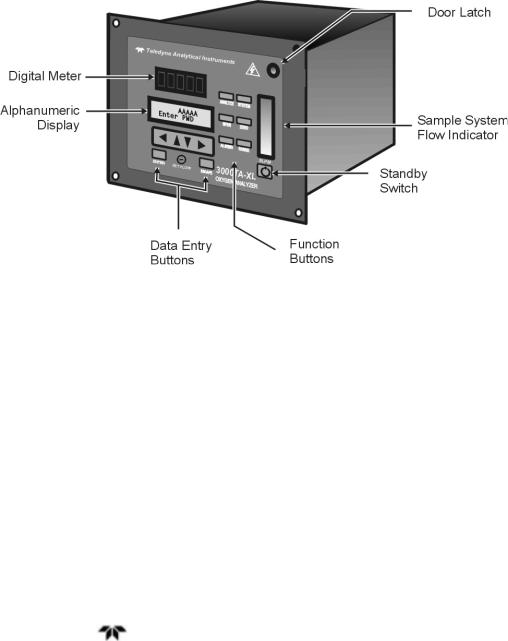
Trace Oxygen Analyzer |
Introduction |
|
|
|
|
|
|
|
1.5 Front Panel (Operator Interface)
The standard 3000TA-XL-EU is housed in a rugged metal case with all controls and displays accessible from the front panel. See Figure 1-1. The front panel has thirteen buttons for operating the analyzer, a digital meter, an alphanumeric display, and a window for viewing the sample flowmeter.
Figure 1-1: Model 3000TA-XL-EU Front Panel
Function Keys: Six touch-sensitive membrane switches are used to change the specific function performed by the analyzer:
Analyze Perform analysis for oxygen content of a sample
gas.
System Perform system-related tasks (described in detail
in Chapter 4, Operation.).
Span Span calibrate the analyzer.
Zero Zero calibrate the analyzer.
Alarms Set the alarm setpoints and attributes.
Range Set up the 3 user definable ranges for the
instrument.
|
|
|
Teledyne Analytical Instruments |
3 |
|

Introduction |
3000TA-XL-EU |
|
|
|
|
|
|
|
Data Entry Keys: Six touch-sensitive membrane switches are used to input data to the instrument via the alphanumeric VFD display:
Left & Right Arrows Select between functions currently displayed on the VFD screen.
Up & Down Arrows Increment or decrement values of functions currently displayed.
Enter Advances VFD display to the next screen in a series or returns to the Analyze screen if none remain.
Escape Backs VFD display to the previous screen in a series or returns to the Analyze screen if none remain.
Digital Meter Display: The meter display is a Light Emitting Diode (LED) device that produces large, bright, 7-segment numbers that are legible in any lighting. It produces a continuous readout from 0-10,000 ppm and then switches to a continuous percent readout from 1-25%. It is accurate across all analysis ranges without the discontinuity inherent in analog range switching.
Alphanumeric Interface Screen: The VFD screen is an easy-to-use interface from operator to analyzer. It displays values, options, and messages that give the operator immediate feedback.
Needle Valve: Needle valve used to adjust flow of gas sample.
Flowmeter: Monitors the flow of gas past the sensor. Readout is 0.2 to 2.4 standard liters per minute (SLPM) of nitrogen.
Standby Button: The Standby button  turns off the display and outputs, but circuitry is still operating.
turns off the display and outputs, but circuitry is still operating.
CAUTION: THE POWER CABLE MUST BE UNPLUGGED TO FULLY DISCONNECT POWER FROM THE INSTRUMENT. WHEN THE CHASSIS IS EXPOSED OR WHEN THE ACCESS DOOR IS OPEN WHILE THE POWER CABLE IS CONNECTED, USE EXTRA CARE TO AVOID CONTACT WITH LIVE ELECTRICAL CIRCUITS.
Access Door: For access to the Micro-Fuel Cell, the front panel swings open when the latch in the upper right corner of the panel is pressed all the way in with a narrow gauge tool. Accessing the main circuit board
Teledyne Analytical Instruments |
4 |

Trace Oxygen Analyzer |
Introduction |
|
|
|
|
|
|
|
requires unfastening rear panel screws and sliding the unit out of the case.
1.6 Rear Panel (Equipment Interface)
The rear panel, shown in Figure 1-2, contains the gas and electrical connectors for external inlets and outlets. Some of those depicted are optional and may not appear on your instrument. The connectors are described briefly here and in detail in Chapter 3 Installation.
Power Connection Universal AC power source.
Gas Inlet and Outlet One inlet and one exhaust out.
Analog Outputs 0–1 VDC oxygen concentration plus 0-
1 VDC range ID, and isolated 4–20 mA DC oxygen concentration plus 4-20 mA DC range ID.
Alarm Connections 2 concentration alarms and 1 system
|
|
alarm. |
|
RS-232 Port |
Serial digital concentration signal |
|
|
output and control input. |
|
Remote Probe |
Used in the 3000TA-XL-EU for |
|
|
controlling external solenoid valves |
|
|
only. |
Remote Span/Zero Digital inputs allow external control of
analyzer calibration.
Calibration Contact To notify external equipment that
instrument is being calibrated and readings are not monitoring sample.
Range ID Contacts Four separate, dedicated, range relay
|
contacts. Low, Medium, High, Cal. |
Network I/O |
Serial digital communications for local |
|
network access. For future expansion. |
|
Not implemented at this printing. |
|
|
|
Teledyne Analytical Instruments |
5 |
|
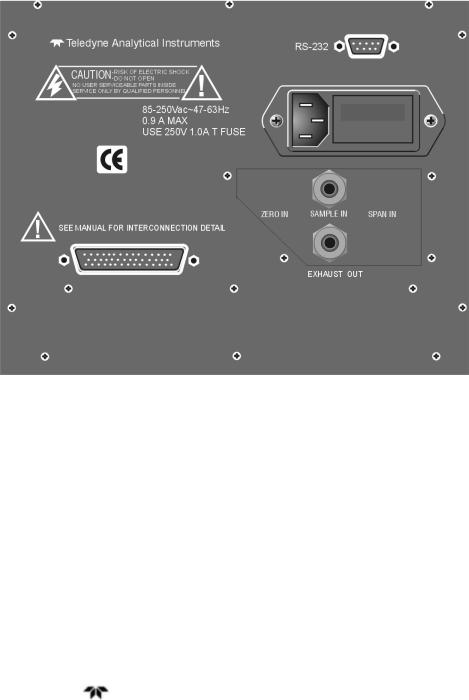
Introduction |
3000TA-XL-EU |
|
|
|
|
|
|
|
Note: If you require highly accurate Auto-Cal timing, use external
Auto-Cal control where possible. The internal clock in the Model 3000TA-XL is accurate to 2-3 %. Accordingly, internally scheduled calibrations can vary 2-3 % per day.
Figure 1-2: Model 3000TA-XL Rear Panel
Teledyne Analytical Instruments |
6 |

Trace Oxygen Analyzer |
Operational Theory |
|
|
|
|
|
|
|
Operational Theory
2.1 Introduction
The analyzer is composed of three subsystems:
1.Micro-fuel Cell Sensor
2.Sample System
3.Electronic Signal Processing, Display and Control
The sample system is designed to accept the sample gas and transport it through the analyzer without contaminating or altering the sample prior to analysis. The Micro-Fuel Cell is an electrochemical galvanic device that translates the amount of oxygen present in the sample into an electrical current. The electronic signal processing, display and control subsystem simplifies operation of the analyzer and accurately processes the sampled data. The microprocessor controls all signal processing, input/output and display functions for the analyzer.
2.2 Micro-Fuel Sensor
2.2.1 Principles of Operation
The oxygen sensor used in the Model 3000TA-XL series is a Micro-Fuel Cell, Model B-2CXL designed and manufactured by Analytical Instruments. It is a sealed plastic disposable electrochemical transducer.
The active components of the Micro-Fuel Cell are a cathode, an anode, and the aqueous KOH electrolyte in which they are immersed. The cell converts the energy from a chemical reaction into an electrical current in an external electrical circuit. Its action is similar to that of a battery.
There is, however, an important difference in the operation of a battery as compared to the Micro-Fuel Cell: In the battery, all reactants are stored within the cell, whereas in the Micro-Fuel Cell, one of the reactants (oxygen) comes from outside the device as a constituent of the sample gas being analyzed. The Micro-Fuel Cell is therefore a hybrid
|
|
|
Teledyne Analytical Instruments |
7 |
|

Operational Theory |
3000TA-XL-EU |
|
|
|
|
|
|
|
between a battery and a true fuel cell. (All of the reactants are stored externally in a true fuel cell.)
2.2.2 Anatomy of a Micro-Fuel Cell
The Micro-Fuel Cell is a cylinder only 1¼ inches in diameter and 1¼ inches thick. It is made of an extremely inert plastic, which can be placed confidently in practically any environment or sample stream. It is effectively sealed, although one end is permeable to oxygen in the sample gas. The other end of the cell is a contact plate consisting of two concentric foil rings. The rings mate with spring-loaded contacts in the sensor block assembly and provide the electrical connection to the rest of the analyzer. Figure 2-1 illustrates the external features.
Figure 2-1: Micro-Fuel Cell
Refer to Figure 2-2, Cross Section of a Micro-Fuel Cell, which illustrates the following internal description.
At the top end of the cell is a diffusion membrane of Teflon, whose thickness is very accurately controlled. Beneath the diffusion membrane lies the oxygen sensing element—the cathode—with a surface area approximately 4 cm2. The cathode has many perforations to ensure sufficient wetting of the upper surface with electrolyte, and it is plated with an inert metal.
Teledyne Analytical Instruments |
8 |
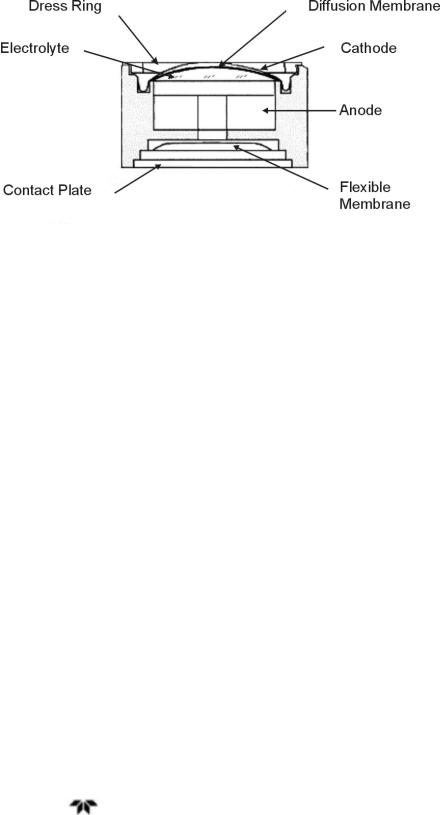
Trace Oxygen Analyzer |
Operational Theory |
|
|
|
|
|
|
|
Figure 2-2: Cross Section of a Micro-fuel Cell (not to scale)
The anode structure is below the cathode. It is made of lead and has a proprietary design which is meant to maximize the amount of metal available for chemical reaction.
At the rear of the cell, just below the anode structure, is a flexible membrane designed to accommodate the internal volume changes that occur throughout the life of the cell. This flexibility assures that the sensing membrane remains in its proper position, keeping the electrical output constant.
The entire space between the diffusion membrane, above the cathode, and the flexible rear membrane, beneath the anode, is filled with electrolyte. Cathode and anode are submerged in this common pool. They each have a conductor connecting them to one of the external contact rings on the contact plate, which is on the bottom of the cell.
2.2.3 Electrochemical Reactions
The sample gas diffuses through the Teflon membrane. Any oxygen in the sample gas is reduced on the surface of the cathode by the following HALF REACTION:
O2 + 2H2O + 4e–→ 4OH– |
(cathode) |
(Four electrons combine with one oxygen molecule—in the presence of water from the electrolyte—to produce four hydroxyl ions.)
|
|
|
Teledyne Analytical Instruments |
9 |
|

Operational Theory |
3000TA-XL-EU |
|
|
|
|
|
|
|
When the oxygen is reduced at the cathode, lead is simultaneously oxidized at the anode by the following HALF REACTION:
Pb + 2OH– → Pb+2 + H2O + 2e– |
(anode) |
(Two electrons are transferred for each atom of lead that is oxidized. Therefore it takes two of the above anode reactions to balance one cathode reaction and transfer four electrons.)
The electrons released at the surface of the anode flow to the cathode surface when an external electrical path is provided. The current is proportional to the amount of oxygen reaching the cathode. It is measured and used to determine the oxygen concentration in the gas mixture.
The overall reaction for the fuel cell is the SUM of the half reactions above, or:
2Pb + O2 → 2PbO
(These reactions are specific to oxygen as long as no gaseous components capable of oxidizing lead—such as iodine, bromine, chlorine and fluorine—are present in the sample.)
In the absence of oxygen, no current is generated.
2.2.4 The Effect of Pressure
In order to state the amount of oxygen present in the sample in parts-per-million or a percentage of the gas mixture, it is necessary that the sample diffuse into the cell under constant pressure.
If the total pressure increases, the rate that oxygen reaches the cathode through the diffusing membrane will also increase. The electron transfer, and therefore the external current, will increase, even though the oxygen concentration of the sample has not changed. It is therefore important that the sample pressure at the fuel cell (usually vent pressure) remain relatively constant between calibrations.
2.2.5 Calibration Characteristics
Given that the total pressure of the sample gas on the surface of the Micro-fuel Cell input is constant, a convenient characteristic of the cell is that the current produced in an external circuit is directly proportional to the rate at which oxygen molecules reach the cathode, and this rate is
Teledyne Analytical Instruments |
10 |
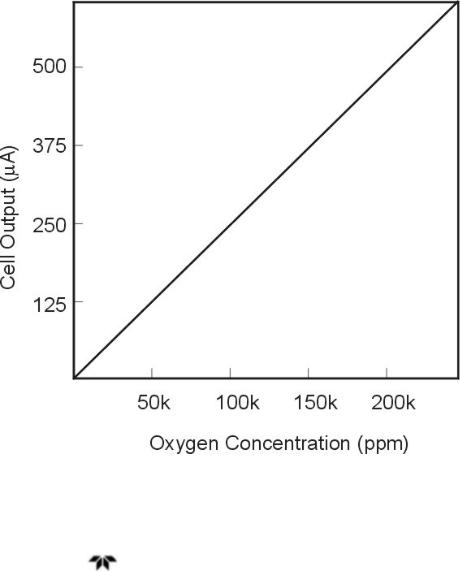
Trace Oxygen Analyzer |
Operational Theory |
|
|
|
|
|
|
|
directly proportional to the concentration of oxygen in the gaseous mixture. In other words it has a linear characteristic curve, as shown in Figure 2-3. Measuring circuits do not have to compensate for nonlinearities.
In addition, since there is zero output in the absence of oxygen, the characteristic curve has close to an absolute zero (less than ± 0.2 ppm oxygen). This means there is usually no need to zero calibrate the instrument. Depending upon the application, zeroing may still be used to compensate for the combined zero offsets of the cell and the electronics.
Figure 2-3: Characteristic Input/Output Curve for a Micro-Fuel Cell
|
|
|
Teledyne Analytical Instruments |
11 |
|

Operational Theory |
3000TA-XL-EU |
|
|
|
|
|
|
|
If, however, a low range accuracy better than 100 ppb is required, then a zero calibration is recommended. See Section 4.4.1.
2.3 Sample System
The sample system delivers gases to the Micro-fuel Cell sensor from the analyzer rear panel inlet. Depending on the mode of operation either sample or calibration gas is delivered.
The Model 3000TA-XL-EU sample system is designed and fabricated to ensure that the oxygen concentration of the gas is not altered as it travels through the sample system.
The sample system for the standard instrument incorporates VCR tube fittings for sample inlet and 1/4” outlet tube connections at the rear panel. The sample or calibration gas that flows through the system is monitored by a flowmeter downstream from the cell. Figure 2-4 shows the piping layout for the standard model.
Figure 2-5 shows the flow diagram for sampling systems used for the three configurations offered as options for this instrument. In the standard instrument, calibration gases can be connected directly to the Sample In port by teeing to the port with appropriate valves.
Teledyne Analytical Instruments |
12 |
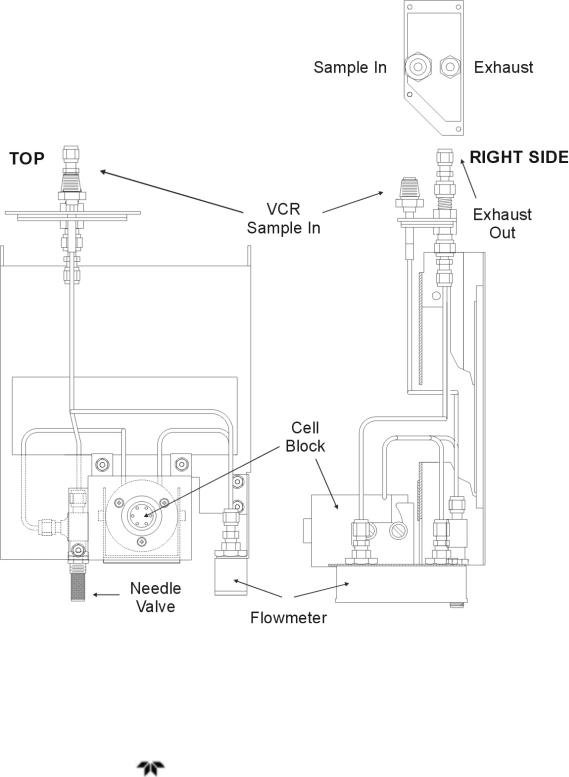
Trace Oxygen Analyzer |
Operational Theory |
|
|
|
|
|
|
|
Figure 2-4: Piping Layout
|
|
|
Teledyne Analytical Instruments |
13 |
|
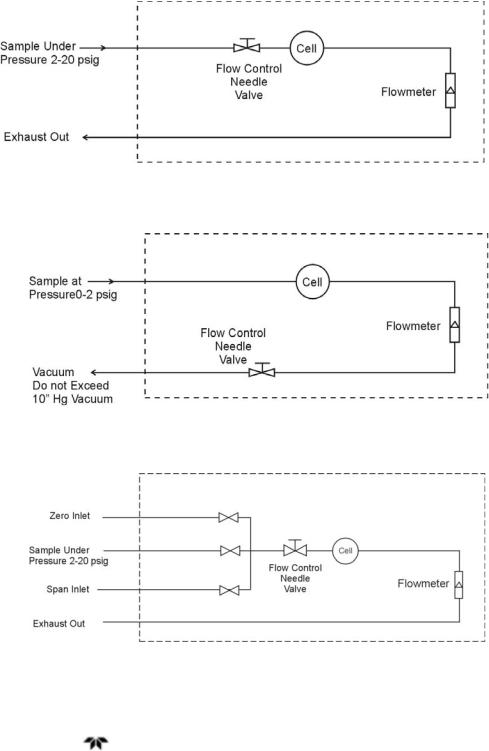
Operational Theory |
3000TA-XL-EU |
|
|
|
|
|
|
|
Figure 2-5A: Flow Diagram—Sample Under Pressure-Standard
Figure 2-5B: Flow Diagram—Low Pressure-Model 3000TA-XL-VS
Figure 2-5C: Flow Diagram—Sample Under Pressure-Model 3000TA-
XL-CV
Teledyne Analytical Instruments |
14 |
